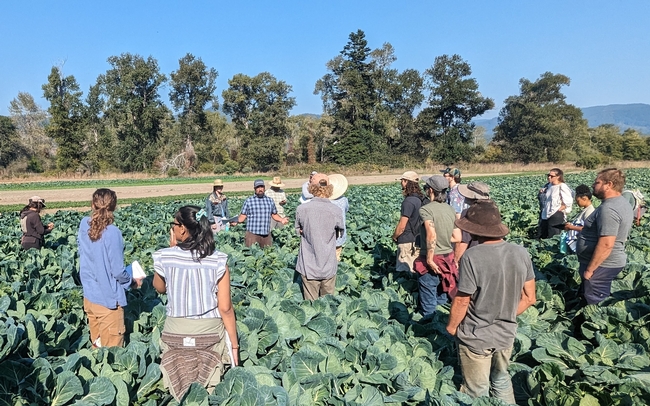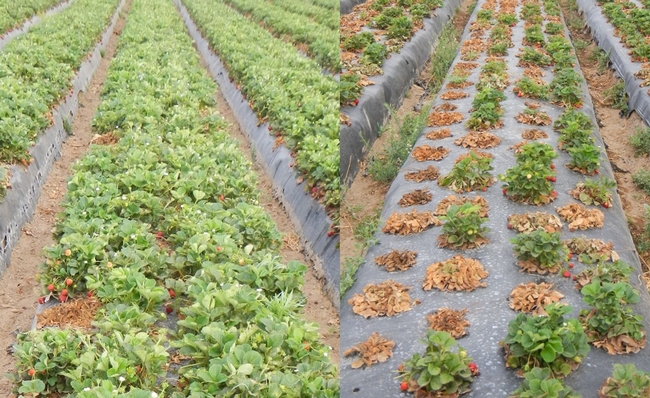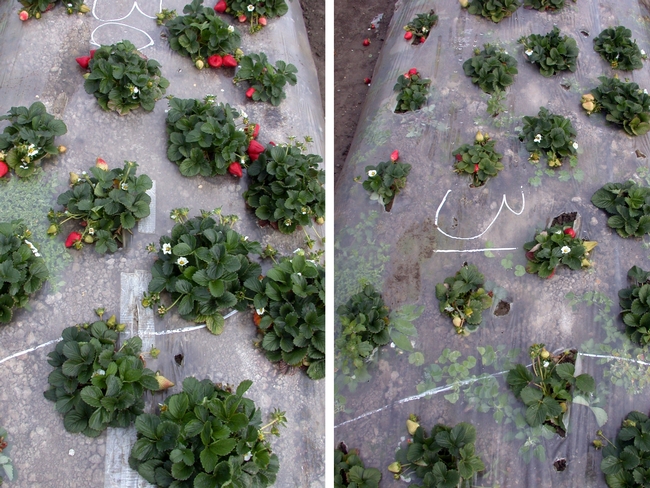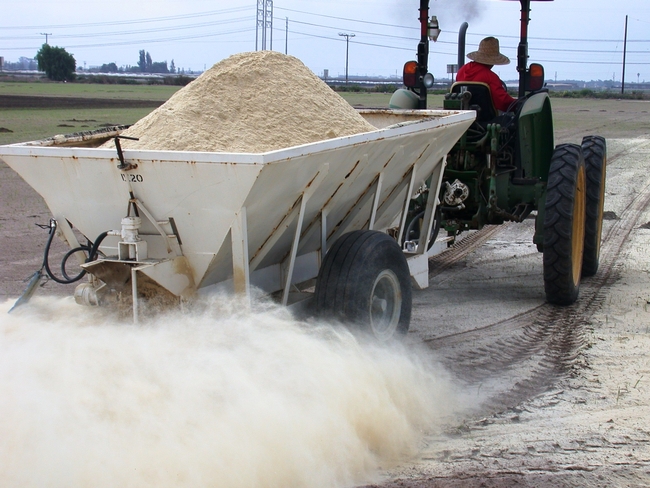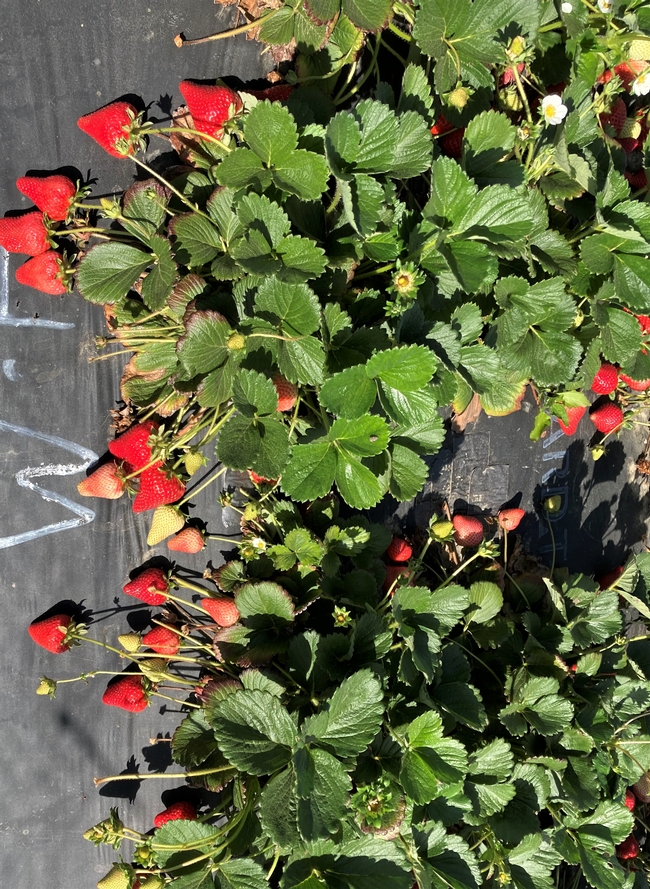Posts Tagged: organic
Lawn-pocalypse! Surviving Drought
Ah, summer! The season of sunburns, pool parties, and… lawn droughts. If your once lush, green carpet now looks like a crunchy brown doormat, you're not alone. Let's dive into why your yard is staging a dramatic death scene and what you can do to...

Bermuda grass and weeds overtaking drought stressed turf grass.
Report outlines top concerns in California organic agriculture
Organic Agriculture Institute needs assessment refines how it can address pressing challenges
The explosive growth of organic agriculture in the U.S. – reflected in a 90% increase in organic farms from 2011 to 2021, according to U.S. Department of Agriculture statistics – has come at a cost for some farmers. With new farming operations increasing the supply of organic commodities, along with consolidation of buyers, growers report that their profit margins are not what they used to be.
Those market size considerations are among the challenges highlighted in a new report detailing the initial findings by the University of California Organic Agriculture Institute on the most pressing needs of the state's organic sector. OAI gathered and analyzed data from 423 responses to an online grower survey, over 60 interviews with stakeholders across the organic community, and additional observations from farm visits and workshops.
The report describes other frequently mentioned systemic priorities, such as maintaining integrity of the term “organic,” developing a market for organic seeds, spreading consumer awareness, and alleviating the burdens of organic certification and reporting.
Shriya Rangarajan, the postdoctoral researcher with OAI leading this statewide needs assessment, said that the reported challenges varied by organic status (fully certified, transitioning to organic, or a mixed farm with some conventional), type of crop, as well as size of the operation. She noted survey respondents were roughly representative of the sector overall – 70% small-scale growers and 30% medium and large.
“Organic is not a homogenous industry, to say the least – small growers and large growers are very different; for small growers, their challenges tend to be financial and regulatory, especially relating to certification requirements and labor,” said Rangarajan. She added that larger growers mentioned different types of challenges, weeds and pest pressures for instance, given the difficulty in controlling managing these at scale without the use or availability of organic inputs.
Organic Agriculture Institute key to sharing resources across state
Another common theme from the assessment is that the organic sector needs more accessible resources to address those myriad concerns. For OAI, established in 2020 under UC Agriculture and Natural Resources, the initial findings validated and refined the direction of its research and extension programs.
“As a new organization, we've been trying to figure out where we fit into this ecosystem and how we can support it,” said Houston Wilson, a UC Cooperative Extension entomology specialist who has served as OAI's director since its founding.
Because OAI was envisioned as a hub of resources and connections for California's organic community, Wilson and his colleagues are especially interested in understanding how its constituent members obtain information – and how OAI can improve their access.
“Growers are finding it difficult to navigate the resources that exist for organic agriculture, like technical information, financial support, compliance and certification support,” Wilson said. "While we'd like to see more resources for organic in general, those that currently exist can sometimes be hard to navigate or it can be hard to know where to go for the right thing – that became really apparent early on.”
While some producers are contacting OAI directly with their questions, Wilson is eager to develop tools and systems that can serve the community more broadly. For example, Wilson and Krista Marshall – OAI's policy and partnerships coordinator – are currently beta-testing a new map tool, built in conjunction with UC ANR's Informatics and GIS (IGIS) team. The map, expected to be ready in fall 2024, will enable users to click on their county and see all available resources related to organic agriculture.
Wilson added that OAI will have four full-time staffers by fall, further expanding its research, extension, and education efforts. After holding four field events this past year, OAI aims to increase activities in the coming year, including not just field events but also online resources, webinars and more. Also, a new training and technical assistance coordinator will be tasked with bringing Cooperative Extension advisors and other technical assistance personnel across the state up to speed on a range of organic topics, so they can more effectively answer questions from clientele in their region.
New survey aims to trace crucial organic knowledge networks
Although the OAI team has gained a sense of how information is shared across the organic community (and started to formalize those interconnections through a California Organic Agriculture Knowledge Network), they are now developing a survey to study those relationships more systematically.
“We're trying to understand what kind of knowledge resources people tap into, which is something that has come up repeatedly in our needs assessment,” Rangarajan said. “We're trying to understand who people are speaking to because, at the end of the day, organic is still a relatively small part of agriculture in California, and that makes it more fragmented. So trying to connect those different parts becomes important.”
Once Wilson has a more nuanced understanding of organic knowledge networks, he will be able to strategize and position OAI – and the UC – as a more effective partner and contributor in the sector.
“Given the history of organic, growers have had to rely on each other a lot,” Wilson explained. “We understand that the university has unique expertise to bring to the table, but we also acknowledge that there's all these other knowledge holders out there, so one of the roles that we see ourselves having is helping to facilitate those connections, strengthen them and increase the frequency of interaction.”
That may include further supporting efforts that connect transitioning organic farmers with experienced growers (a mentorship program led by Certified California Organic Farmers, or CCOF), or giving more structure to grower-researcher partnerships that can help address a host of production challenges. In OAI's grower survey, weed management topped the list, followed by water and disease issues, all exacerbated by climate variability.
“I think a lot of the real innovation changes are coming through growers experimenting with their own practice,” Rangarajan explained. “From a research perspective, one of the best ways to take this forward would be to formalize those experiments in some way so that knowledge becomes more reportable.”
And collaboration on “organic topics,” such as finding alternatives to synthetic pesticides, are a boon to the entire agricultural sector – conventional growers included.
“Everyone is trying to reduce pesticide use; everyone is trying to reduce environmental impacts,” Wilson said. “You don't have to be certified organic to benefit from organic research; these practices can be used by anyone.”
The report with OAI's initial findings on organic needs can be found at: https://ucanr.edu/sites/organic/files/396228.pdf.
Electric weed control research updates
From the eOrganic and Performance and Economics of Electric Weed Control in Organic Perennial Crops Project: Electric Weeding Research Updates (Click HERE to see the presentations) Electric Weed Control in Orchards • Tong Zhen, Ph.D....
Electrical weed control in organic blueberry - Oregon State cooperators
Several of us are part of a multi-state project on electrical weed control in organic blueberry and orchard crops. Tong Zhen is the lead grad student researcher on the UC Davis part of the project and we are working closely with our counterparts at...
Organic strawberry yields boosted by technique refined through UCCE research
Anaerobic soil disinfestation helps suppress weeds, disease without fumigants
Troubled by puny plants, low yields and persistent mite problems, third-generation Southern California strawberry grower Glen Hasegawa was ready to give up on his transition from conventional to organic 12 years ago.
“I've always liked a challenge – but it turned out to be more of a challenge than I thought it would be!” he said.
But then, with the help of scientists including Oleg Daugovish, UC Cooperative Extension strawberry and vegetable crop advisor in Ventura County, Hasegawa tried a technique called anaerobic soil disinfestation (ASD). When applied correctly, the multi-step ASD process creates a soil environment that suppresses pathogens and weeds and makes for healthier, more robust crop growth.
“Back in the day, it was really hard to get the plant growing vigorously in organic,” said Hasegawa, owner of Faria Farms in Oxnard. “So we started using the ASD and then you could definitely see that the plant had more vigor and you could grow a bigger, better plant using it.”
Seeing that he could produce yields “in the neighborhood” of those grown in conventional strawberry fields fumigated with synthetic fumigants, Hasegawa was able to expand his original 10 acres of organic strawberries to 50 acres.
“I guess you could say I'm kind of a convert,” he said, noting that he now applies ASD to all his acreage each year in late spring.
Joji Muramoto, UC Cooperative Extension specialist in organic production based at UC Santa Cruz, has been experimenting with ASD since it was first brought to the U.S. from the Netherlands and Japan in the early 2000s. Carol Shennan, a professor in the Department of Environmental Studies at UCSC, and Muramoto were among the first to try the technique in California. They found that ASD successfully controlled an outbreak of Verticillium wilt – caused by the pathogen Verticillium dahliae – at UCSC's small organic farm in 2002.
Since then, Shennan, Muramoto, Daugovish and their colleagues have seen encouraging results at 10 trial sites across the state.
“We demonstrated that ASD can provide comparable yields with fumigants, in side-by-side replicated trials,” Muramoto said.
ASD promotes host of beneficial changes to soil ecosystem
ASD comprises three basic steps: incorporating a carbon source that is easily digestible by microbes in the soil (traditionally, rice bran has been used), further encouraging fermentation by covering the soil with plastic to limit oxygen supply, and finally adding water through drip irrigation to initiate the “anaerobic” decomposition of the carbon source and maintain the three-week “cooking” process.
The resulting cascade of chemical, microbiological and physical changes to the soil creates an ecosystem that is both conducive to strawberry growth – and inhospitable to pathogens and weeds.
“It's not like a pesticide where you have a mode of action, and thus resulting in ‘A' and ‘B' for you,” Daugovish explained. “There's a sort of cocktail of events that happens in the soil; they all happen interconnectedly.”
Compared to similar fields that did not undergo the process, ASD-applied organic strawberry fields across California have seen yields increase by 60% to 70% – and even doubling in some cases, according to Daugovish.
The UCCE advisor also shared the story of a longtime grower in Ventura County, who came to him with fields in “miserable” condition; they were plagued by one of the world's worst weeds, yellow nutsedge, and infected with charcoal rot, a disease caused by the fungus Macrophomina phaseolina. But after applying rice bran and following the ASD recipe, the grower saw phenomenal results.
“The only complaint he said to me was, ‘Now I have too many berries – we have to have more pickers to pick the berries!'” Daugovish recalled.
Via researchers' meetings, online resources, on-farm demonstration trials and word of mouth from peers, use of ASD by California strawberry growers has grown significantly during the past two decades. Tracking the purchase of rice bran, Muramoto estimated that about 2,500 acres were treated by the ASD-related practices in 2023 – covering roughly half of the 5,200 total acres of organic strawberries in California.
Muramoto directly links the growth of California organic strawberry production – which now comprises about 13% of total strawberry acreage in the state – with the increasing adoption of ASD.
“If you remove the acreage with the applied rice bran over the last 10 years or so, organic strawberry acreage is just flat,” he said.
Within the last decade, acreage of organic strawberries with ASD-related practices increased by 1,640 acres, which is a boon for air quality, human health and long-term soil vitality. According to Muramoto's calculations, that increase in organic acreage translates to a reduction of about 465,000 pounds of fumigant active ingredients that would have been used in growing conventional strawberries.
“There are hundreds of reports of acute illnesses related to fumigation in the record, so it's very important to find alternatives to fumigants,” said Muramoto, citing California Department of Pesticide Regulation documents.
Research continues to make ASD more economical, effective
The popularity of ASD has come at a price, however, for organic strawberry growers.
“There's more organic out there, and I think most of the organic guys are using it, so there's more demand on the rice bran; the price has been steadily going up every year, like everything else,” said Hasegawa, adding that he has been trying to decrease the amount of carbon while maintaining ASD's efficacy.
On top of greater demand from other growers and from beef cattle and dairy producers (who use rice bran as feed), the price also has increased due to higher costs in transporting the material across the state from the Sacramento Valley. So Daugovish and his colleagues – including Peter Henry, a U.S. Department of Agriculture plant pathologist – have been searching for a cheaper alternative.
“We all want an inexpensive, locally available, reliable, easy to use and functional carbon source, which sounds like a big wish list,” Daugovish said.
Carbon sources such as bark, wood chips, or compost are ineffective, as the crucial ASD microorganisms are choosy about their food.
“Microbes are just like cows; you can't feed them straight wood; they get pretty angry,” Daugovish explained. “And if you feed them something with too much nitrogen, they can't digest it – they get the runs. Microbes are the same way – you have to have the right proportion of stuff so they feel comfortable doing what they're doing.”
In search of an ideal replacement, researchers tried and ruled out grass clippings, onion waste, glycerin and coffee grounds. Finally, they pivoted to a material with properties very similar to rice bran: wheat bran, in the form of wheat middlings (also called midds, a byproduct of flour milling) and dried distillers' grain (DDG, a byproduct of ethanol extraction).
After field experiments in Santa Paula, the UC and USDA researchers found that midds and DDG were just as effective at controlling soilborne pathogens and weeds as rice brain – but at 25% to 30% less cost. Their results were published last year in the journal Agronomy.
“Not surprisingly, the wheat bran has worked almost exactly the same as rice bran,” Daugovish said.
He and Muramoto are now conducting trials with wheat bran at commercial fields, and the initial results are promising. Daugovish said the grower at one site in Ventura County has seen a 90% reduction in Macrophomina phaseolina, the causal pathogen of charcoal rot, in the soil – and an 80% to 90% drop in yellow nutsedge germination. They are waiting for final yield numbers after the coming summer.
While ASD has been beneficial to organic productivity and soil health, both Daugovish and Muramoto acknowledged specific limitations in suppressing the “big three” strawberry diseases: Verticillium wilt, Fusarium wilt and charcoal rot. In coastal areas with cooler soil temperatures, for example, ASD can actually exacerbate the latter two diseases, as the fungal pathogens feed on the rice bran.
“We know it works at warmer temperatures, but, practically, it's hard to do in coastal California,” Muramoto said. “It would be nice if we can find a way to suppress Fusarium wilt at a lower temperature, but we don't have it right now.”
That's why researchers emphasize that ASD is not a “silver bullet.” It's just one tool in the organic toolbox, which includes careful crop rotation, disease-resistant strawberry varieties and better diagnostic tests that help growers pinpoint outbreaks and make the application of various methods more targeted and more efficient.
And scientists will continue to optimize ASD to make it more effective and economical for growers in the different strawberry regions of California – from the Central Coast to the Oxnard Plain.
“We know it can work really well; it's just finding the most sustainable way to do this in our region,” Daugovish said. “We've got to just have an open mind and keep trying.”

